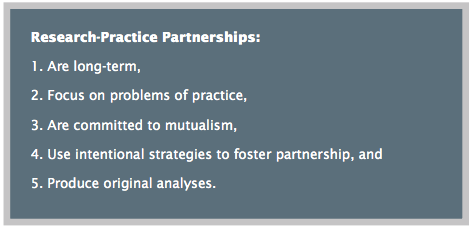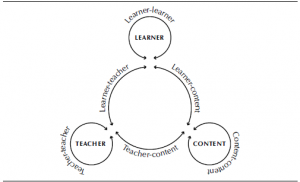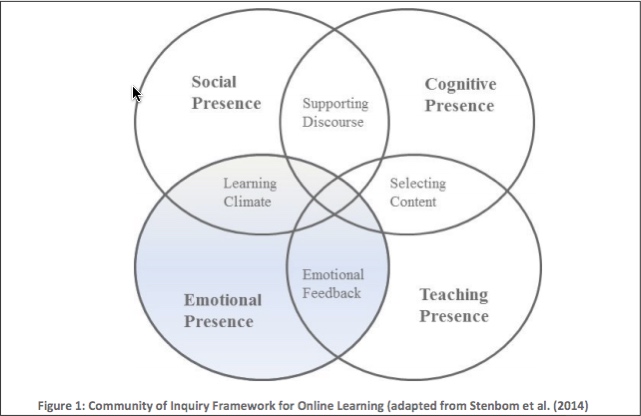Six weeks ago I received a very surprising email from Prof. Carla Padel de Oliviera the Rector of Universidade Aberta (Portugal Open University). She invited Susan and me to come to Lisbon where I was to be awarded a Doctorat Honoris Causa.
Of course, the first thing I had to do was to ask Google what this degree was all about. I found it is the equivalent of the Honourary Doctorate awarded at most Canadian Universities. In Google’s words ”The Doctorat honoris causa (D.hc) is an award conferred by a University to individuals who have made outstanding achievements in fields like academics, culture, or humanitarian efforts, or have made significant contributions to the state, nation, or world.”
Once I recovered from the shock I recalled my 4 or 5 visits, over the years, to Universidade Aberta and the colleagues and friends I have met as a member of an International Advisory Committee for LE@D – the University’s Distance Education and eLearning Laboratory. I also played a very minor roles in a couple of EU research projects led by the University.
To be honest, like many academics, I had held a very secret ambition or maybe just a faint hope, that I would someday be awarded such an honour. It is perhaps the nicest way to finish any academic career. However, I never shared this aspiration with anyone and never stayed awake at night plotting to get such an award. One does not fill out an application for such a degree. But when and if and when it happens – well, what can you say but “muito abrigada.” (MANY thanks in Portugese)
This all happened a few weeks just before Susan and I left for a three-week holiday and conference of the World Conference of the International Council for Distance Education in New Zealand. This was a great holiday but five days after we arrived home, we were due to leave for Portugal. A first order of business was to get my suit dry cleaned, shoes polished and to develop a Graduate Research seminar for the Masters and Doctoral students in e-learning research at the University. I understood that I didn’t have to do much in the actual award ceremony. However, after I arrived, I found that a response to the award was expected – but no more than 25 minutes! I am a professor, so I can usually profess about almost anything without too much trouble for less than 25 minutes. Beyond that, I didn’t know what to expect – but I thought I could at least tell a few stories and say a heart-felt thanks.
The Trip and Lisbon
The trip with Air Canada was thankfully unremarkable except that the passport machines at the airport in Lisbon refused to accept my passport. The same thing happened on the way home, necessitating long lines to talk to a human Customs Agents. Perhaps my passport is getting as tired of International travel as I am, though the passport gets to be reborn in 2027!
We arrived, on time, after eleven hours in the air, on a sunny Sunday morning in Lisbon. I managed to prebook an Uber ride to the hotel, which turned out be remarkably easy and the driver was very friendly. Sadly, I didn’t get the message that the University had a driver waiting to pick us up. I’m not used that type of service.

Casa de Sao Mamede
Our hotel was located in an 18th century mansion – the Casa de Sao Mamede on Rue de Escola Politicnia – not far from the University of Lisbon and next door to the Palace that houses the executive offices of Universidade Aberta. Our room had 12 foot ceilings, 14 inch stone walls and a number of small ‘reading rooms”. The only thing missing was an elevator, but the staircase was broad and richly carpeted. We have stayed in too many ‘modern hotels’ – so this one was a real treat.

Lisbon Christmas market
After a brief nap, we headed to the old town and a visit of a European Christmas Market. Of course, we had some hot mulled wine and managed to NOT buy any more Christmas ornaments, nor pay for a photo with Santa’s elves. We noticed and appreciated the 30 deg. C. increase in temperature from Edmonton – though Lisboners were complaining of the cold!
After unpacking, we realized that we had forgotten to pack my suit jacket, so the first item of business on Monday was to find a men’s clothing store and buy a new suit jacket. I have been trying to de-clutter my closet of sports coats (without a great deal of success) since I retired. Luckily, I managed to resist purchasing the 1,000 Euro jacket and escaped – down only 100 Euros. The closet now has a new sibling.
We ended the afternoon at the Lisbon Botanical Gardens.
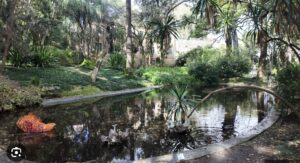
Lisbon Botanical Gardens
It was the most ‘well labeled” botanical garden that we had ever visited and featured Europe’s largest collection of palm trees – over 70 species ranging from 5 foot bushes to 25 meter giants. That night we dined with our major host and the director of the LE@D centre, António Teixeira and his wife Maria do Carmo at a traditional Portuguese restaurant. I’ve learned to like eating squid!
The Award Ceremony
Tuesday was the big ceremony. We slept in and after a walk Susan helped me practice my speech. The Award Ceremony was held on Universidade Aberta Day- an annual celebration of the University’s founding – this year their 37th. As typically, the hundred or so gowned academics all lined up to proceed into the Hall – only here they file in not by faculty, but in order of rank at the University. The procession was led by the Rector and myself, followed by other members of the platform party. A great 8 piece choir welcomed us in.
Unlike most Canadian convocation award ceremonies, there were no students receiving graduation certificates. The Rector first gave a speech (thankfully with a paper English translation copy for me). This was followed with achievement awards to two Masters degree graduates and two PhD graduates and certificates were awarded to retiring staff members. Finally, the Portuguese Secretary of State for Higher Education brought greetings and congratulations to the University on its anniversary from the government.
The second half began with the singing of the University Anthem, in harmony, by the choir. My friend Antonio Teixeira then introduced me (in Portuguese), so I am not sure what he said, but no doubt it was somewhat over-exaggerated. Next, a faculty member from Porto, Isabel Huet e Silva, whom I had not met gave an equally long overview of my career and contributions to distance education and e-learning. She told me that she had spent a few hours going through my 35-page CV. When they had asked me for a copy of this CV, I didn’t think they really needed, or wanted, the “the full meal deal” – so I sent a two-page AI generated summary. But she wanted the whole thing.
Then it was my turn.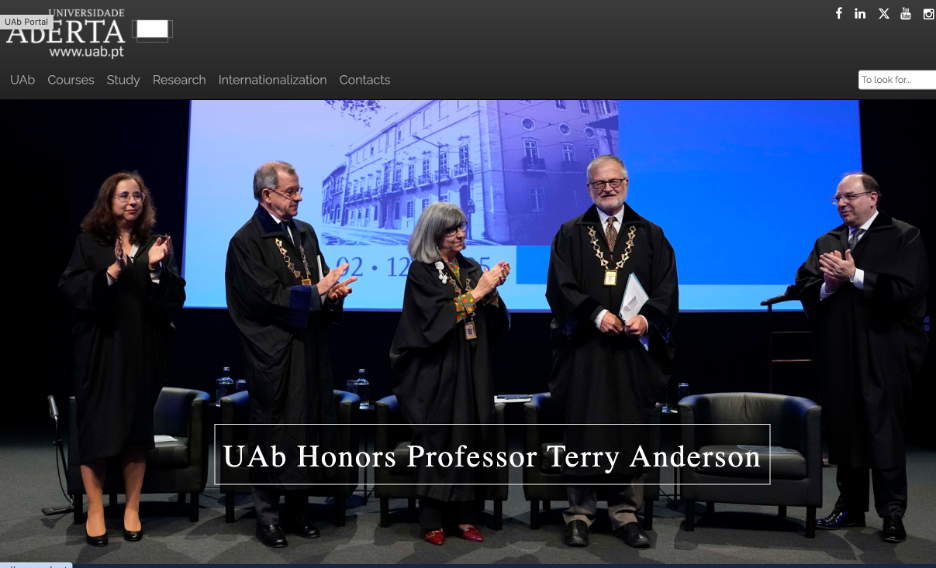
The Rector and her assistant “gowned me” and presented me with graduate certificate and a chain (representing the Doctor degree) to hang around my neck – then the podium was mine.
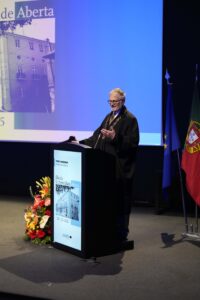 I confess to being a wee bit teary-eyed, but managed to get though the speech. I was a bit overwhelmed with the long, standing ovation and clapping from the 200 or so attendees that concluded the event. The ceremony ended with another choir selection and we marched out.
I confess to being a wee bit teary-eyed, but managed to get though the speech. I was a bit overwhelmed with the long, standing ovation and clapping from the 200 or so attendees that concluded the event. The ceremony ended with another choir selection and we marched out.
Luckily, outside the hall, I was handed a glass of port and survived the reception line – with many congratulatory comments and photos.

Screenshot
The day ended with drinks and a dinner hosted by the Rector with a number of the Vice Rectors, the platform party, and of course Susan and I.
What a day! I learned that the University had only awarded 8 of these degrees in its 35-year history. I joined Canadians Sir John Daniel and my friend Tony Bates with this honour, but I note that I am the first recipient of this award, from Universiade Aberta, who was not born in Europe.
Graduate Seminar
The next day, I gave a graduate student seminar. It was entitled “Encontro com o Professor Terry Anderson – Projecting the Futures of Research in Open, Distance and Digital Education.” Of course I talked too much, however, the 80 or so attendees (70 via zoom, including a couple of long-time Portuguese friends from elsewhere in the world) seemed to enjoy the talk. It was based partially on slides I had created with help from my friend Rory McGreal and AI). The talk focused on the impact of Generative Artificial Intelligence (AI) on educational research production and publication. I have posted the slides on Slideshare. There were lots of good questions.
One of the problems with getting old and now talking about AI in education, is that many of these students have read my earlier articles and books. And now, they want to know what impact AI will have on those ideas. Great questions, but ones I haven’t really thought about – I suppose (and hope) leaving them lots of papers to write!
Finally, Lina Margado, a former Director of the LE@D centre who had first invited me to the University years ago, gave me a photo album, documenting my visits to the University over the years. – An invaluable memory gift!
Conclusion
On the way home, I was reminded of a graffiti message that I had read 38 years ago when I was working on my Master’s degree at the University of Oregon. It was inscribed on the grout (with other grouty quotes), between the tiles in a stall in the men’s bathroom in a pub near the university. It read:
“Some men strive for groutness, others have it thrust upon them”.
I hope I will always remain humble enough to count myself in the later group.
PS. The University invited a number of diplomats to this event (Lisbon is the capital of Portugal). The Canadian ambassador didn’t show, but Susan was seated beside the Turkish Ambassador. At the end of the ceremony he turned to her and said ‘I assume you are Terry’s wife?” “We have a saying in my country: ‘Behind every strong man, there is a strong woman’. This is true in Canada as well as Turkey and I am a very lucky guy!


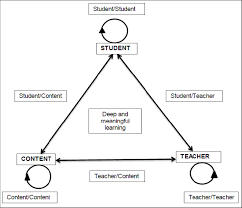
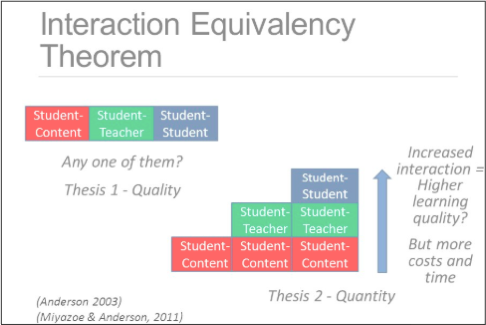
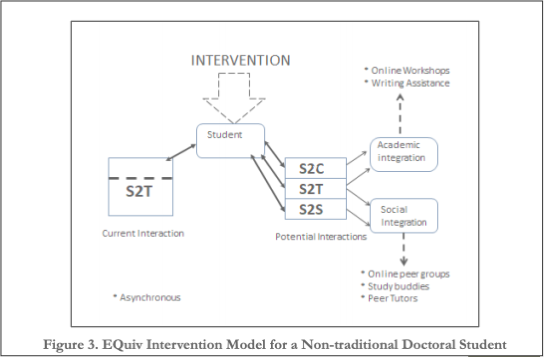





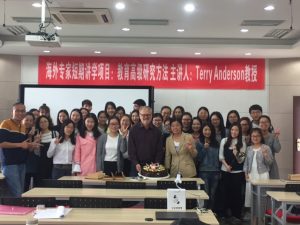
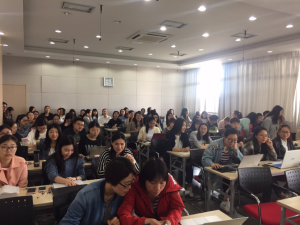


 Perhaps I was not the best person to ask, as I have very mixed feelings about quality control systems dealing with emerging technologies and pedagogies. In particular, I hate it when quality standards impeded innovation and opportunity for experimentation. I hope I got across the complexity- if not a solution! I illustrated the challenges of defining quality by presenting the different quality measures associated with each of the Three Generations of Distance Education pedagogy from a
Perhaps I was not the best person to ask, as I have very mixed feelings about quality control systems dealing with emerging technologies and pedagogies. In particular, I hate it when quality standards impeded innovation and opportunity for experimentation. I hope I got across the complexity- if not a solution! I illustrated the challenges of defining quality by presenting the different quality measures associated with each of the Three Generations of Distance Education pedagogy from a 
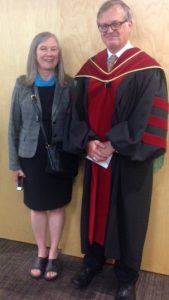 to me at the beginning of the ceremonies. Rory’s introduction contained comments from Mark Brown, Alan Tait, Morten Paulsen and Wayne Macintosh – thanks to each of you. The life stream of the whole convocation ceremony is streamed at
to me at the beginning of the ceremonies. Rory’s introduction contained comments from Mark Brown, Alan Tait, Morten Paulsen and Wayne Macintosh – thanks to each of you. The life stream of the whole convocation ceremony is streamed at 
